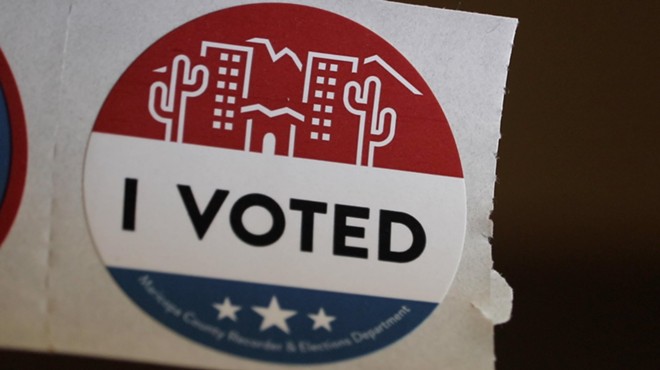Tuesday, January 17, 2012
Presidential Candidate Charles Skelley: The Won-2-3 Plan "Fixes the US Economy by Fixing Manufacturing"
After winning 50 votes in the 2008 Arizona GOP primary, Republican Charles Skelley is back for another shot at winning the hearts and minds of Arizona Republicans.
Here's his platform:
THE WON-2-3 PLAN — FIXES THE US ECONOMY BY FIXING MANUFACTURINGPart 1: Defining the core US economic problems in 2011
This WON-2-3 plan is named after Wealth of Nations, Book 2, Chapter 3
Adam Smith's "macroeconomic" principles (from Book 2, chapter 3, of Wealth of Nations) can be used to solve interrelated US economic problems of high structural unemployment, huge Trade Deficits, unsustainable Federal Budget deficits, and entitlements. Putting additional people to work in the US Manufacturing sector will improve all four of these issues simultaneously.
The US Manufacturing sector lost 5.8 million jobs during 1998-2011; and the US now has a $700 Billion/year Trade Deficit for goods. (i.e. The Sep 2011 Trade deficit for goods was $59 Billion.) If these millions of lost US Manufacturing jobs are not replaced quickly, then the huge US Trade Deficit will soon ruin the value of all US dollars.BOOK 2, CHAPTER 3, IN WEALTH OF NATIONS EXPLAINS HOW A NATIONAL ECONOMY WORKS
Book 2 Chapter 3 in Adam Smith's text Wealth of Nations shows that the "products" generated from Productive Labor are what gives value to the money circulating in a society. All nations have some jobs that are characterized as Unproductive Labor. But whatever money is paid for Unproductive Labor is diluting the economic purchasing power of Productive Labor.
Book 2 Chapter 3 shows that societies "progress" by continually increasing the amount of Capital that backs their Productive Labor. Therefore a "good" government should place its maximum emphasis on domestic generation of "products" within its borders. And a "bad" government over-emphasizes its Unproductive Labor.
Book 2, Chapter 3, of Wealth of Nations also indicates that "entitlements" (to pay people NOT to work in the present or future) should be structured by backing the remaining Productive Labor by adequately large amounts of extra Capital equipment.
"The productive powers of the same number of laborers cannot be increased, but in consequence either of some addition and improvement to those machines and instruments which facilitate and abridge labor; or of a more proper division and distribution of employment." Wealth of Nations, Book 2 Chapter 3.32 (*1)
Many modern economists recognize that these strategies from Wealth of Nations work properly in about 95% of all years, and in all countries. For example, the Kennedy-era economic boom succeeded because US Manufacturing jobs increased by 23% during 1961-1969. (*3)
THE WORLD TRADE ORGANIZATION HAS REPACKAGED ADAM SMITH, USING BORDER TAX ADJUSTMENTS
Around 1970, the World Trade Organization (WTO) repackaged Adam Smith's strategy, and started encouraging Border Tax Adjustments (BTAs). (*2) WTO rules for "Border Tax Adjustments" now encourage each nation to create a tax-buffer, to isolate and protect that nation's "Productive Labor" from handicaps imposed by that nation's "Unproductive Labor". The WTO wants a nation's import tariffs to be balanced by export subsidies. BTAs are revenue neutral, but they are actually more powerful economic tools than import tariffs alone.
"Yankee ingenuity" had allowed the US trade balance for goods to be a surplus every year during 1900-1970. But the US trade balance for goods swung into a deficit in 1971, and has been getting chronically worse ever since. Due to our heritage of "Yankee ingenuity", the US leaders were not prepared to effectively counteract chronic US Trade Deficits. The US Federal government actually borrowed enough money to pay for 100%+ of the US merchandise Trade Deficits every year during 1971-1995, and also during 2003-2011 . This "kicked the can down the road", instead of taking focused action (like President Kennedy did) to make the US Manufacturing sector grow its equity faster. And consequently, the underlying US economic problems kept getting more severe.
US JOBS DATA REVEALS A MANUFACTURING COLLAPSE, AND A 13-YEAR HIRING FREEZE FOR "PRIVATE SECTOR, MINUS HEALTHCARE AND EDUCATION"
As shown in Table 1 (from BLS data), US Manufacturing has been hurt far worse than any other sector of the US economy during 1998-2011. Adam Smith's favorite sector of the economy (i.e. Private Sector, minus Healthcare and Education) actually lost 2.4 million jobs during 1998-2011.
Unfortunately most US job growth during the last 13 years has occurred in three categories that Adam Smith calls Unproductive Labor. 84% of the overall US job growth has been in Healthcare. And 39% of the overall US job growth has been in Government jobs. And 18% of all US job growth has been in Education. These three Unproductive Labor categories, combined, accounted for 140% of all US job growth during 1998-2011.
Table 1
PERCENTAGE CHANGE IN VARIOUS US EMPLOYMENT SECTORS FOR 1998 THROUGH AUG 2011
Education services (NAICS 61) +41% gained 0.9 million jobs
Healthcare services employment (NAICS 62) + 36% gained 4.5 million jobs
Government employment (Fed,State,Loc) + 10% gained 2.1 million jobs
All Private Sector employment + 3% gained 3.1 million jobs
Private Sector, minus Healthcare & Educ. - 2% lost 2.4 million jobs
Construction employment - 10% lost 0.6 million jobs
Manufacturing employment (NAICS 31-33) - 33% lost 5.8 million jobs
adapted from BLS data: (*3) ftp://ftp.bls.gov/pub/suppl/empsit.ceseeb1.txt
INADEQUATE MANUFACTURING PROFITABILITY IS A ROOT CAUSE OF THE DOMESTIC US MANUFACTURING SECTOR COLLAPSE
US manufacturing has endured overwhelming price competition from overseas, which makes it unprofitable to manufacture in the US. Therefore generic Federal Budget Deficits have been failing to stimulate the US Manufacturing sector.
US Manufacturing (during the 12 year period 1999-2011) had an average "after tax" profit margin of only 6% on its sales dollar (as tracked by the Value Line Industrial Composite Index of 941 industrial companies). (*4)
But the average imported product sells in the US at a price 12.5% cheaper than in its country-of-origin, due to Border Tax Adjustments in 150 nations which are our trading partners. (*5)
Most US manufacturers cannot cut their selling prices enough to overcome the foreign BTA subsidies. Therefore the US Manufacturing sector (as a whole) cannot compete with foreign products, unless the relative tax structure is modified. The US Manufacturing sector needs the Federal government to create a level playing field for US Manufacturing, by neutralizing foreign BTA subsidies on import/export products.
Moreover, another macro-economic problem is also harming US Manufacturing in a big way. Since 1980, US Healthcare costs have risen much faster than healthcare costs in foreign nations. US Healthcare spending is currently 19% of GNP. And US Healthcare costs would need to be cut by 1/3 to restore a ratio for "US vs foreign Healthcare" costs that is equivalent to the situation that existed during 1965-1980. (*6) Since 1980, rising US Healthcare costs have handicapped the profitability of US Manufactured products, by this additional 6% of GNP.
Due a healthcare cost handicap, the US probably needs a HIGHER Border Tax Adjustment today, in contrast to what would be needed if US Healthcare costs were closer to the healthcare costs in nations that are our trading partners.
THE US HAS NEGLECTED ADAM SMITH'S ECONOMIC ADVICE FOR THE LAST 25 YEARS
The most recent Federal effort to make domestic Manufacturing more profitable was probably the permanent 10% Investment Tax Credit, which existed from 1975 through 1986. Manufacturing is capital intensive; so an ITC benefited Manufacturing more than other sectors of the US economy. The Manufacturing sector obtained 44% of all ITC money, although it employed only 20% of the US workforce during 1975-1986. (*7) When the permanent 10% ITC was first adopted (by the Ford presidential administration), US Manufacturing jobs increased by 14% during 1975-79. (*3)
After ITC was canceled in 1986, the Federal government did not use any economic tool to specifically help US Manufacturing. Hindsight indicates that the ITC should have been increased, instead of canceled, in 1986. During 1987-2011, many US manufacturers have been "downsizing" their work force, to place more Working Capital behind the average US Manufacturing job.
Unfortunately, the Federal government has resorted to a crude economic tool for the last 4 decades — either RAISE the total Federal budget deficit, or LOWER the total Federal budget deficit. The Federal Budget Deficit paid for at least 100% of the US merchandise Trade Deficit every year from 1971-1995, and also every year during 2003-2011. Over-reliance on this "aggregate" deficit spending strategy has gradually made both Federal Budget Deficits and US Trade Deficits worse.
Many modern economists recognize that "aggregate" deficit spending by a central government (i.e. Keynesian stimulus) only works properly in about 5% of all years. Keynes's relevant 5% occurs when two conditions apply: a) US deflation is creating a "liquidity trap"; and b) the US has a Trade Surplus (as it did in the 1930's) so US manufacturing can create products cheaper than foreign manufacturers. During the forty year period 1971-12011, the only years when condition a) applied were 2008-2009. But condition b) never applied during 1971-2011.
This explains why the use of "aggregate Federal budget deficits" had such dismal results during 1971-2011. The US was running Trade Deficits during 1971-2011, which meant that foreign manufacturers were the lowest-cost source of products. Therefore Federal deficits stimulated FOREIGN manufacturers, but not US manufacturers. And of course Federal budget deficits impoverished the entire future of the US economy.
But targeted government spending to let domestic Manufacturing prosper (i.e. following Adam Smith's principles) can work properly in about 95% of all years, and in nearly all nations.
THE WON-2-3 PLAN — FIXES THE US ECONOMY BY FIXING MANUFACTURINGPart 2: Crunching numbers to identify a credible fix for the US economy
US JOBS DATA REVEALS A 13-YEAR HIRING FREEZE FOR "PRIVATE SECTOR, MINUS HEALTHCARE"; AND A MANUFACTURING COLLAPSE
As shown in Table 1 (from BLS data), US Manufacturing has been hurt far worse than any other sector of the US economy during 1998-2011. Adam Smith's favorite sector of the economy (i.e. Private Sector, minus Healthcare and Education) actually lost 2.4 million jobs during 1998-2011.
Unfortunately most US job growth during the last 13 years has occurred in three categories that Adam Smith calls Unproductive Labor. 84% of the overall US job growth has been in Healthcare. 39% of the overall US job growth has been in Government jobs. And 18% of all US job growth has been in Education. These three Unproductive Labor categories, combined, accounted for 140% of all US job growth during 1998-2011.
Table 1PERCENTAGE CHANGE IN VARIOUS US EMPLOYMENT SECTORS FOR 1998 THROUGH AUG 2011
Education services (NAICS 61) +41% gained 0.9 million jobs
Healthcare services employment (NAICS 62) + 36% gained 4.5 million jobs
Government employment (Fed,State,Loc) + 10% gained 2.1 million jobs
All private sector employment + 3% gained 3.1 million jobs
Private Sector, minus Healthcare & Educ. - 2% lost 2.4 million jobs
Construction employment - 10% lost 0.6 million jobs
Manufacturing employment (NAICS 31-33) - 33% lost 5.8 million jobs
adapted from BLS data: (*3) ftp://ftp.bls.gov/pub/suppl/empsit.ceseeb1.txt
RESTORING AN ADEQUATE NUMBER OF US MANUFACTURING JOBS
Replacing 5.8 million recently-lost US Manufacturing jobs (from 1998-2011) would allow a substantial fraction of the long-term unemployed US citizens to find work again. But 5.8 million new jobs is not enough restore full prosperity throughout the US. For Oct 2011, the BLS reported that 16% of the US workforce is unemployed or underutilized. (*8) This BLS data (i.e. 16% of the US workforce) indicates that about 21 million adult US citizens currently cannot find full-time work in the job category of "Private sector, minus Healthcare".
In 1998, 13% of the US workforce, and 7% of all US citizens, worked in US Manufacturing. But the number of official US citizens has increased by 42 million during 1998-2011.
Therefore today the US deserves more Manufacturing jobs than the ones that existed in 1998. 2.9 million additional US Manufacturing jobs should roughly counter-balance the increased number of official US citizens during 1998-2011. (i.e. 7% of the 42 million more official US citizens — correlates to needing 2.9 million more US manufacturing jobs than what existed in 1998.)
When all the above issues are lumped together, it seems conservative to estimate that the US today needs close to 8.7 million new US Manufacturing jobs BEFORE any other category of US jobs sees job growth.
If the current US work force (131 million jobs) could magically receive 8.7 million more Manufacturing jobs overnight — then Manufacturing would supply 14.6% of all US jobs. That percentage should be compared to data for 1986 (i.e. the year when Investment Tax Credit was foolishly eliminated). In 1986, Manufacturing supplied 18% of all US jobs. (*3) This demonstrates that adding 8.7 million new US Manufacturing jobs in the near future is not an extravagant plan.
CALCULATING HOW MUCH ADDITIONAL CAPITAL IS NEEDED BY US MANUFACTURING (NAICS 31-33)
It is possible to calculate the amount of new Capital that is needed today by Private Sector employers, to restore US Manufacturing to a healthy condition. For such an estimate, it is wise to use broadly based average data about the US economy. S&P500 companies had about 18.7 million employees in 2010. (*9) Meanwhile the S&P500 index had a combined book value around $5.2 trillion dollars. Therefore the "average" US industrial job, today is backed by about $280K of equity Capital (in addition to employer debts).
Based on a capital requirement of $280K per average US industrial job —— it follows that about $2.4 Trillion of new "equity" Capital is likely to be needed by the current US Manufacturing companies, for creating the 8.7 million more US Manufacturing jobs.
This new Capital is needed by the US Manufacturing sector alone. In the North American Industry Classification System, these Manufacturing jobs are in NAICS 31-33. (*10) The incremental Capital would not be spread among other US employment sectors.
In September 2011, US corporations (non-farm, non-financial) have total equity Capital of $15.8 Trillion, as tracked by the Federal Reserve Bank. (*11) Therefore $2.4 Trillion more equity capital would be a 15% increase in total US Corporate equity capital (for non-farm, non-financial corporations).
The incremental Capital situation can also be discussed on a year-by-year basis. Capital equity for the US Manufacturing sector should have been growing faster — approximately $180 billion per year faster throughout 1998-2011. Since the US did not yet have Border Tax Adjustments, the simplest way to put additional Capital into domestic Manufacturing would have been through Federal tax subsidies and outright tax credits. (example: President FDR's "cost-plus manufacturing" principle could have been revived, but today it would aim at producing peacetime goods for immediate use by middle class US citizens.)
US tax strategy would have displayed good stewardship of the US economy if US taxes on domestic US Manufacturing operations (NAICS 31-33) had been lower by about $180 billion per year for each of the 13 years in 1998-2011. And common sense indicates that other categories of Federal spending (during 1998-2011) should have been reduced by a corresponding $180 Billion per year, to compensate for the additional NAICS 31-33 Manufacturing subsidies.
It should be noted that Border Tax Adjustments automatically increase the rate of capital growth by a nation's Manufacturing sector (by raising profit margins for domestic manufacturing). Therefore a government greatly reduces (or perhaps completely eliminates) its need to inject government-tax-dollars into its Manufacturing sector, if a government uses Border Tax Adjustments. BTAs are revenue neutral. The overall totals for import and export price adjustments counterbalance each other.
2.4 YEAR PAYBACK TIME (= 41% ANNUAL NET PROFIT) TO US SOCIETY AS A WHOLE, FROM THE EQUITY CAPITAL INVESTMENT BEHIND THE AVERAGE US MANUFACTURING JOBIn America, the average Manufacturing employee has to create about $115K/year of "value added" above and beyond the costs of raw materials, capital, etc. (*12) The average of both large and small businesses is about $200K/year of gross revenues per employee. Small manufacturers average a little over $100K/year of Gross Revenue per employee; but large manufacturers use more capital and generate an average of $300K/year Gross Revenue per employee (*13)
Based on "value added" of $115K/year for the average Manufacturing employee, together with an average "equity Capital" usage of $280K per S&P 500 Manufacturing employee —- it follows that US society can average a 2.4 year Payback time for each additional US Manufacturing job. This correlates to 41% annual profit to US society, as a whole, for each additional equity Capital dollar that is added to private sector Manufacturing Employers (NAICs 31-33).
A way to double-check these estimates is to multiply 5.8 million new Manufacturing jobs by the "value added" parameter of $115K/year per employee. This result is $667 Billion/year of additional US economic activity, which basically wipes out the current US Trade Deficit for Merchandise, $700 Billion/year.
For the past 40 years, the Federal Budget Deficit has been used to pay for the US merchandise Trade Deficit. But this new "WON-2-3" plan eliminates the US Trade Deficit. It allows the Federal Budget Deficit to become $0/year, stabilizes the National Debt, and strengthens the payroll tax base for both Social Security and Medicare.
Choosing to add even more US Manufacturing jobs (e.g. 2.9 million more Manufacturing jobs), beyond merely neutralizing the current Trade Deficit for goods, can allow the US "standard of living" to improve for average US citizens, by having more "stuff" to consume. That is one reason why this article suggests a target total of 8.7 million new US Manufacturing jobs.
TRILLIONS OF DOLLARS OF CAPITAL HAVE ALREADY BEEN ACCUMULATED TO MAKE THE US MORE "SOCIALLY SECURE"; BUT THE TRUST FUND GOES UNUSED
Approximately this same quantity of money ($2.4 Trillion for fixing entitlements, Trade Deficits and unemployment) has already been accumulated by the Federal government; but the money is sitting around, currently unused, in various national trust funds.
Book 2, Chapter 3, in Wealth of Nations contains a passage that indicates how the Social Security trust fund should be used, to let one portion of society support a "retired" portion of society.
"The productive powers of the same number of laborers cannot be increased, but in consequence either of some addition and improvement to those machines and instruments which facilitate and abridge labor; or of a more proper division and distribution of employment." — Wealth of Nations, Book 2 Chapter 3.32 (*1)
The Social Security Trust Fund in 2010 was hoarding a total of $2.4 Trillion. (*14) That amount of Capital could have capitalized about 8.7 million additional "average Industrial jobs" today in the US — if the US tax structure had allowed the 941 Value Line Industrial Composite companies to accumulate $2.4 Trillion more "equity" in their US Operations during 1998-2011.
Common sense, and Book 2 Chapter 3 in Wealth of Nations, both indicate that all federal "entitlements" (to pay people for not working in the present or in the future) should be funded by increasing the total amount of US Capital which backs US jobs in the category of Productive Labor.
QUANTIFYING THE PROPER PERCENTAGE RATE FOR US BORDER TAX ADJUSTMENT
Since 1970, the World Trade Organization has recommended that each nation should adopt Border Tax Adjustments, to protect that nation's Productive Labor. (*2)
Today, 150 nations have already adopted Border Tax Adjustments. And the US is the only major nation that has not yet adopted a Border Tax Adjustment. Among the developed (or industrialized) nations, 80% of the OECD nations use rates higher than 14% for their Border Tax Adjustment. (*15)
It would not be surprising if the US today needs to adopt a BTA rate near 14%. Four-fifths of our direct trading partners need BTAs higher than 14%, to stabilize their economies in the modern world.
A proper BTA percentage rate for the US can be discovered by iterative adjustments. For example, the US could initially adopt a 9% lumped Border Tax Adjustment. During an introductory six-year period, the BTA rate would be incrementally changed each year, until the US Trade deficit is driven down to zero. In this way, US Manufacturing jobs can return to a healthy level. And the associated Payroll taxes on an increased number of US Manufacturing jobs will strengthen US social programs (Social Security, Medicare, Medicaid).
AN IMPORTANT US LEGISLATIVE CHANGE IS TO ADOPT BORDER TAX ADJUSTMENTS
No national sales tax would be needed for adopting 'lumped" Border Tax Adjustments, which are imposed at US borders. (This is a worthwhile observation, because a substantial group of US voters have been reluctant to start a Federal sales tax.)
Any Federal Congress could implement this iterative Border Tax Adjustment program. A lumped BTA rate could be adjusted upward each year (or downward if necessary) until the US foreign Trade Deficit for goods is reduced to zero.
Alternately, a "section 201 investigation" through the International Trade Commission (ITC) of the Federal government could give any US President the authority impose adequate Border Tax Adjustments. Bureaucratic mechanisms for getting the ITC involved have been explained by the US Justice Department. (*16)
This is a very important change, because 150 foreign nations have been using their own Border Tax Adjustments to ruin the profit margins of the US Manufacturing sector.
(*1) http://www.econlib.org/library/Smith/smWN8.html
(*2) http://www.worldtradelaw.net/reports/gattpanels/bordertax.pdf
(*3) ftp://ftp.bls.gov/pub/suppl/empsit.ceseeb1.txt
(*4) http://www.valueline.com/Markets/Commentaries/The_Value_Line_Industrial_Composite_-_March_11,_2011.aspx
(*5) http://www.prosperousamerica.org/2009/10/20/pat_choate_data_on_value_added_taxes/
(*6) http://www.kff.org/insurance/snapshot/OECD042111.cfm
(*7) http://www.irs.treas.gov/pub/irs-soi/80cointcrre.pdf
(*8) http://www.bls.gov/news.release/empsit.t15.htm
(*9) http://www.standardandpoors.com/products-services/articles/en/us/?assetID=1245315661537
(*10) http://www.bls.gov/iag/tgs/iag31-33.htm
(*11) table B.102, line 32, in www.federalreserve.gov/releases/z1/current/z1r-5.pdf
(*12) http://www.ic.gc.ca/cis-sic/cis-sic.nsf/IDE/cis-sic31-33pere.html#per3
(*13) http://www.gazelles.com/columns/Revenue%20per%20Employee.pdf
(*14) http://grandfather-economic-report.com/deficit-trusts.htm
(*15) http://www.oecd.org/document/20/0,3343,en_2649_33739_41751636_1_1_1_1,00.html
(*16) http://www.justice.gov/olc/ustr2ltr.htm
Tags: Project White House 2012 , Charles Skelley , Arizona presidential primary , Arizona news , Tucson news , Video


















